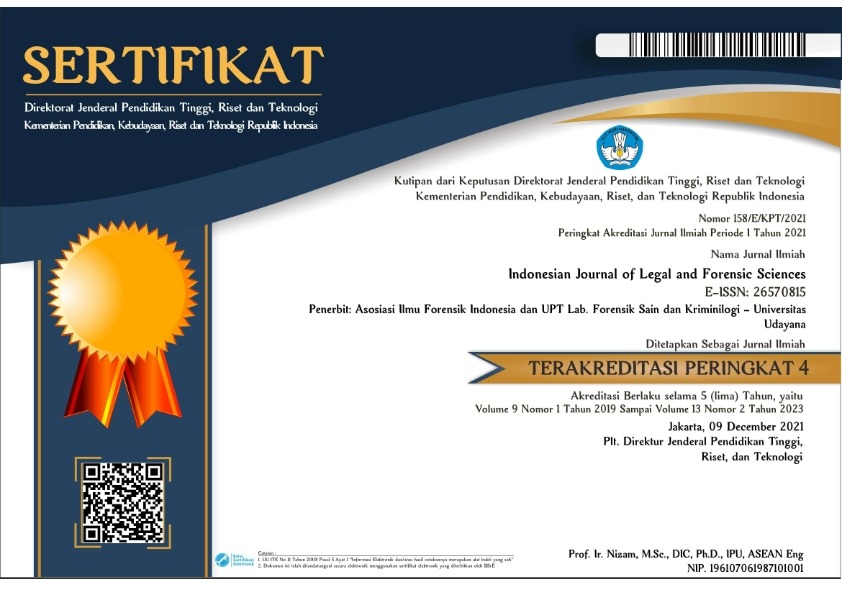Identifikasi Golongan Darah ABO dengan Metode Absorpsi Elusi pada Sampel Bercak Darah dari Lingkungan yang Berbeda
Abstract
Background: identification of ABO blood group is easier with fresh blood samples than with dry blood samples. A commonly used method for determining blood type in dry blood samples is the absorption elution method. This method is very sensitive and can indirectly detect the presence of antigens. Purpose: this study aims to study changes in ABO blood group in dry blood sample from different environments using absorption elution method. Methods: this study used a static group comparison design with 16 dry blood spot samples collected from subjects with a known blood type and stored for 8 weeks under two different conditions indoors and outdoors. Blood samples were then tested for ABO blood group by absorption elution method, and the resulting data were processed using descriptive analysis. Results: testing samples taken from the room showed the results of 56.25% change and 43.75% did not change the blood group. Examination of samples from outside the room showed 12.50% had changes and 87.50% had no changes in blood type. Conclusion: it can be concluded that there was a change in blood group in the dry blood spot sample due to environmental influences, and there were fewer changes in blood group in the indoor sample than in the outdoor sample.
Downloads
References
[2] B. Susilo, I. K. Junitha, and Y. Ramona, “Perubahan Golongan Darah Dan Identifikasi Bakteri Yang Berperan Dalam Merubah Golongan Darah,” Metamorf. J. Biol. Sci., vol. 7, no. 1, p. 96, 2020, doi: 10.24843/metamorfosa.2020.v07.i01.p13.
[3] R. Jatmiko Andi, “Ir - perpustakaan universitas airlangga,” Perpust. Univ. Airlangga, no. Dm, pp. 1–8, 2019.
[4] K. Landsteiner, “ABO Blood Type Identification and Forensic Science,” pp. 1–4, 2016.
[5] E. Auma et al., “Using Dried Blood Spots for a Sero-Surveillance Study of Maternally Derived Antibody against Group B Streptococcus,” pp. 1–11, 2023.
[6] N. Bynum and K. Moore, “Dried Blood Spot Analysis as an Emerging Technology for Application in Forensic Toxicology,” 2016.
[7] B. Xu et al., “Biodegradable Polymer-Based Sirolimus-Eluting Stents With Differing Elution and Absorption Kinetics,” vol. 67, no. 19, 2016, doi: 10.1016/j.jacc.2016.03.475.
[8] I. Sari, B. Bastian, and N. Pathia, “Analisa Pengaruh Waktu Terhadap Perubahan Golongan Darah Pada Sampel Bercak Darah,” J. Ris. Kesehat. Poltekkes Depkes Bandung, vol. 14, no. 1, pp. 167–172, 2022, doi: 10.34011/juriskesbdg.v14i1.2024.
[9] T. Mayangsari, N. Nurfaizah, I. R. Aziz, and I. Masse, “Pemeriksaan golongan darah sistem absorpsi-elusi pada sampel darah kering,” Filogeni J. Mhs. Biol., vol. 2, no. 1, pp. 1–7, 2022, doi: 10.24252/filogeni.v2i1.27414.
[10] I. Masse, “Optimalisasi Waktu dan SSuhu Inkubasi Pada Pemeriksaan Golongan arah Metode Absorpsi-Elusi,” vol. 2, no. 1, pp. 29–37, 2022, doi: 10.54579/jfe.v2i1.18.
[11] M. P. Sen, M. Vanishree, S. Hunasgi, R. Surekha, A. Koneru, and V. Manvikar, “A comparison of absorption inhibition and absorption elution methods for estimation of ABO blood groups in saliva,” vol. 1, pp. 1–4, 2015, doi: 10.15713/ins.jmrps.1.
[12] M. Masyrur, I. K. Junitha, and M. W. Proborini, “Perubahan Golongan Darah Berdasarkan Pengaruh Waktu dan Mikroorganisme Yang Berperan,” Metamorf. J. Biol. Sci., vol. 6, no. 2, p. 165, 2019, doi: 10.24843/metamorfosa.2019.v06.i02.p05.
[13] A. Börsch-supan, A. J. Potter, J. Cofferen, and E. Kerschner, “Dried blood spot collection , sample quality , and fieldwork conditions : Structural validations for conversion into standard values,” no. September 2020, pp. 1–13, 2021, doi: 10.1002/ajhb.23517.
[14] Y. T. Utami, S. P. Hastuti, and B. Nurcahyo, “Identifikasi Golongan Darah O dengan Metode Absorpsi Elusi pada Sampel Darah Kering yang Terdapat pada substrat Kain Jeans dalam Waktu dan Lingkungan Berbeda,” J. Biol. Indones., vol. 17, no. 2, pp. 165–173, 2021, doi: 10.47349/jbi/17022021/165.
[15] Z. D. Rofinda and R. Susanti, “Gambaran Golongan Sekretor dan Nonsekretor yang Dokter Diperiksa Melalui Saliva Mahasiswa Pendidikan Fakultas Kedokteran Universitas Andalas,” vol. 5, no. 1, pp. 20–24, 2016.
[16] J. Handono, S. Kusuma Wijaya, and A. Soefi Ibrahim, “Deteksi Aglutinasi Secara Otomatis Untuk Uji Golongan Darah Tipe Abo Berbasis Kertas,” FaST-Jurnal Sains dan Teknol., vol. 1, no. 1, pp. 15–25, 2017.
[17] Falak, “Agglutination Reaactions,” 2019.
[18] A. B. W. Putra, D. S. B. Utomo, and M. D. Rahmawan, “Verifikasi Golongan Darah Manusia Berbasis Citra Dijital Menggunakan Logika Fuzzy,” JST (Jurnal Sains Ter., vol. 4, no. 1, pp. 23–32, 2018, doi: 10.32487/jst.v4i1.448.
[19] N. Hasri, “Penentuan Golongan Darah Sistem ABO dengan Sampel Darah yang Telah Terdegradasi pada Barang Bukti Forensik dengan Metode Absorpsi-Elusi,” no. July, 2021.
[20] R. Bk, “O riginal A rticle ABO blood grouping from hard and soft tissues of teeth by modified absorption – elution technique,” vol. 5, no. 1, 2013, doi: 10.4103/0975-1475.114559.
[21] I. G. P. D. Suyasa, N. T. Wulansari, N. P. Kamaryati, G. A. D. Mastryagung, N. K. Sutini, and M. Rismawan, “Pemeriksaan Golongan Darah dan Rhesus pada Anak Kelas 4,5, dan 6,” Paradharma, vol. 1, no. 2, pp. 115–119, 2017.
[22] L. L. Priyam R Velani, Preetam Shah, “Determination of ABO Blood Groups and Rh Typing from Dry Salivary Samples,” pp. 100–104.
[23] S. Darmawati, “Penentuan Golongan Darah Sistem Abo Dengan Serum Dan Reagen Anti-Sera Metode Slide,” Gaster, vol. 17, no. 1, p. 77, 2019, doi: 10.30787/gaster.v17i1.330.
[24] I. gede putu darma Suyasa, nadya treesna Wulansari, ni putu Kamaryati, gst ayu dwina Mastryagung, ni kadek Sutini, and M. Rismawan, “Pemeriksaan Golongan Darah dan Rhesus pada Anak Kelas 4 , 5 , dan 6 Sekolah Dasar di Desa Tribuana Kecamatan Abang Kabupaten Karangasem,” J. Parad., vol. 1, no. 2, pp. 115–119, 2017.
[25] W. Murti and V. G. V. Putra, “Studi Pengaruh Perlakuan Plasma Terhadap Sifat Material Antibakteri Kain Kassa Menggunakan Minyak Atsiri (Zingiber Officinale Rosc),” J. Teor. dan Apl. Fis., vol. 8, no. 1, pp. 69–76, 2020, doi: 10.23960/jtaf.v8i1.2432.



















